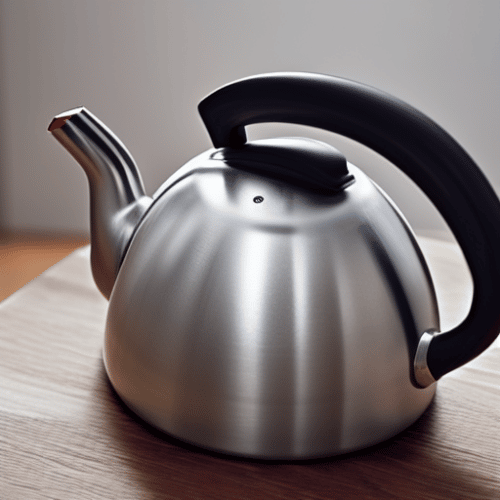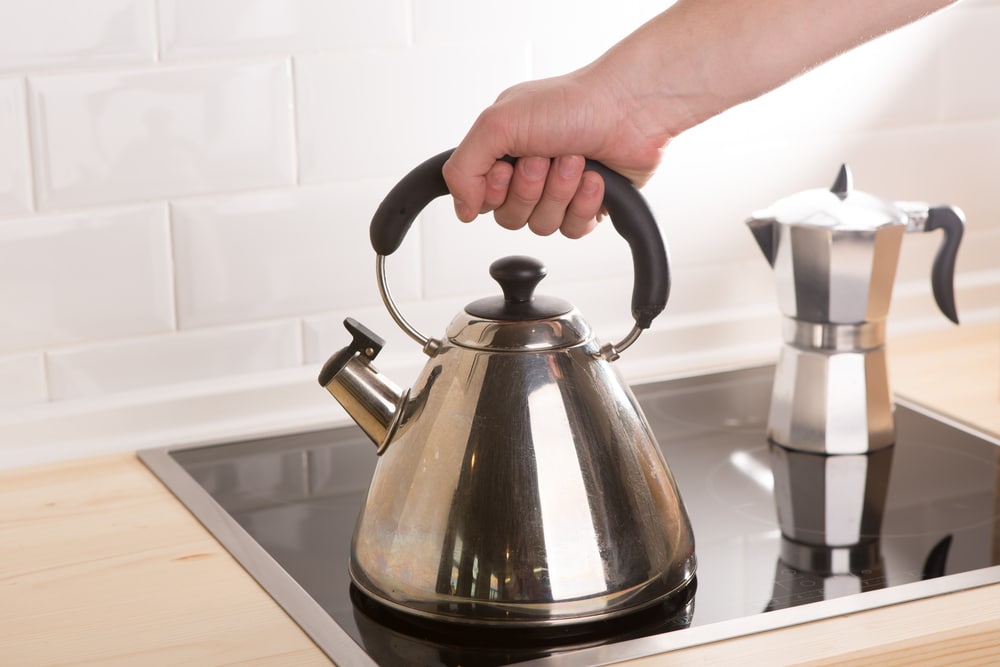Last Updated on
Most homes have their kettle or teapot for brewing up delicious hot drinks all year round. Tea kettles date back throughout the decades, but they’re still among the most efficient and simple ways to heat water to enjoy a nice cup of tea.
Although tea kettles are quite simple products, they can be a little difficult to understand if you’ve never used one before. You might not know whether you’re supposed to brew the tea in the kettle or how long you should leave the kettle on the stove.
A stovetop tea kettle is a world away from the more modern electric kettles many households have today. Here’s what you need to know about how to use a stovetop tea kettle.
The Basics of Using a Kettle on the Stove
Using a kettle on the stove to boil water isn’t the same as using an electric kettle. With an electric kettle, you plug your device into an outlet, fill the container with water, and flip a switch. Electric kettles were invented to provide a convenient option for people who love tea but don’t want to spend a lot of time making hot water.

A tea kettle is a slightly more traditional approach. First and foremost, it’s worth noting that a kettle on the stove, often made with stainless steel, is designed to heat water, not brew tea. Similar to electric kettles, it’s not a good idea to put tea or tea leaves in your stovetop kettle, as the residue can clog various parts of the device and stop it from working properly.
Just as you would with electric tea kettles, you’ll use your stovetop kettles to heat water, then pour the boiling water into a separate teapot or mug to create a cup of tea. Many stovetop kettles do have a strainer that comes with them if you can use them to make tea directly on the stove. While a whistling stovetop kettle might be clogged by tea residue, stovetop kettles with filters can handle tea leaves without any major problems.
If you have a modern kettle, check for the presence of an infuser or strainer where you can place tea leaves while you’re brewing your tea. You may prefer to add the tea leaves to the boiling water after removing the kettle from the heat to prevent burning.
Using a Tea Kettle to Make Tea
The first step in using any new device correctly, including your tea kettle, or electric tea kettle, is checking the instructions. Every non-electric and electric kettle should come with some guidelines on safe use. It’s important to be cautious when dealing with hot water, so make sure you’re taking the appropriate safety precautions.
Start by checking if your tea kettle is just for boiling water or whether you can place tea leaves in with the hot water to brew them at the same time. Next, clean your tea kettle thoroughly to ensure you get the most delicious flavour from your hot water and tea leaves.
Whether you’re using a whistling kettle or a more modern stovetop kettle, there will be a limit to how much you should fill the kettle. Look for instructions to help you but leave enough space at the top of the kettle for the kettle to boil. Remember, the water in your kettle can rise and bubble as it heats up. You should generally only use enough water to fill your cup (or slightly more).
Turn your stovetop to the desired temperature to boil water slowly. Generally, you won’t want to turn it up to the hottest temperature straight away unless you’re making herbal and black tea. If you’re having green tea or white tea, the water in your kettle should be steaming rather than boiling.
Making Your Tea
Once you know the water in your tea kettles or whistling kettle is at the right temperature, you can turn off the stove. It can take a little practice to heat the water to the perfect temperature every time. It helps to keep an eye on the kettle as you heat the water and use a timer when necessary.
If you can’t add tea leaves to the kettle as you heat the water for safety reasons, you can remove the kettle from the stove, and then add your leaves. Most experts agree it’s best to pour the water in a kettle over the tea leaves to infuse the drink correctly.
You can use a potholder to keep your kettle safe when you’re making tea. After the water boils, or you know the water is ready, you can add some tea leaves to your cup or infuser and pour the hot water over it. Be careful when you’re pouring to make sure you don’t overflow the cup.
Rather than placing tea leaves directly within your tea kettle, it’s better to fill your teacup with water and add an infuser with your chosen leaves inside. This is similar to when you use an electric kettle and a teabag to create a good cup of tea.
You can practice pouring your water using the spout of your tea kettle. A whistling kettle or traditional kettle with water can be different to handle than an electric kettle.
Tips for Using a Tea Kettle
Rather than placing tea leaves directly within your tea kettle, it’s better to fill your teacup with water and add an infuser with your chosen leaves inside. This is similar to when you use an electric kettle and a teabag to create a good cup of tea. If you have a new tea kettle that you want to keep safe, make sure you don’t place the kettle in cold water immediately after boiling the water in it, as the high heat followed by the low heat can damage the materials.
Place the kettle on a heat-resistant surface, or use a potholder after you’re done using it to let the boiling water remaining cool down naturally.
To get the best experience when you use your kettle, remember to:
• Watch the kettle when it’s on the stove, even if the kettle has a whistle to let you know when the water is about to boil. The whistle won’t always arrive at the perfect time, so by the time your kettle is whistling. You might need to rush into your kitchen to stop the heating process.
• Practice pouring: Practice pouring your water at different levels of boil with your new tea kettle and its unique spout. Different kettles have different kinds of spout designs, so it can take a while to get used to the perfect pour. You can have a lot of fun as you pour various teas over time.
• Measure timing options: Tracking the amount of time it takes to get your kettle to the perfect point for a good pot of tea could be a great way to make sure you get your drinks exactly how you like them.
• Avoid using glass cups: Because you pour water at various levels of boil temperature into a cup when you’re making tea with a tea kettle, it’s best to avoid using glass. glass can easily shatter while you’re pouring if you’re not careful.
• Experiment with using strainers and other products to improve the quality of your tea. You can try different heating levels with your whistle-based kettle, remove or add the lid, or use the straining features to see which practices give you the best teas.
• Always clean your tea kettle. This is to remove any unwanted taste and smell from it. Keeping your kettle clean means, you get to enjoy the full flavour of your tea.
Is a Traditional Kettle Better Than an Electric Kettle?
There’s nothing better than the sound of a whistle on a traditional stovetop kettle for some people. The features of a stovetop kettle are a little different from an electric kettle so they might be preferred among more dedicated tea enthusiasts.
For instance, with an electric kettle, you’re sending the same amount of power to your kettle regardless of what kind of teas you’re making. Your kettle keeps heating until the water is boiled. With a stove tea kettle, you can enjoy more delicate teas because you don’t have to wait until the water boils. Instead, you can heat your water to the point of steaming.
Time to Brew
Whichever style you go for, make sure you learn to make tea properly with the kettle type you’re using. And remember, when you make tea, it’s usually a good idea to avoid adding the tea leaves or strainer inside the kettle until you’ve already stopped boiling the water. This should reduce the risk of any over-brewing problems or burning, which affects the tea’s flavour.
Now you know how to use a stovetop tea kettle and some basics of making tea, you can enjoy homebrewing any time you like!
Do you have other tips you’d like to share when using a stovetop tea kettle? We’d love to hear them! Let us know in the comments how you make your tea at home!
Rebekah is a writer who loves to explore new products and find hacks that make life easier. She has a knack for all things home improvement, health and fitness. So you’ll often find her on Pinterest or browsing Houzz for ideas.
She’s always looking for the next thing to fix up around the house or what gadget might be just right for her lifestyle. Rebekah enjoys exploring new recipes, taking care of her family, and making sure she stays healthy with regular workouts at the gym.



